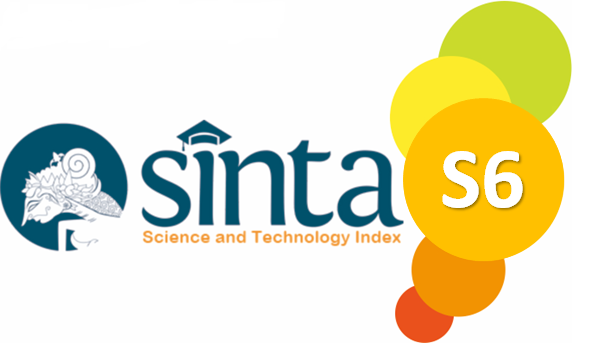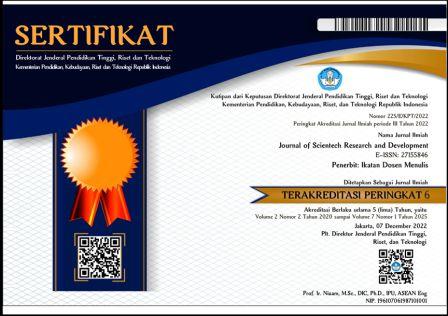POTENSI MINYAK BULUS (Amyda cartilaginea) SEBAGAI ANTIAGING: STUDI IN SILICO TERHADAP COLLAGENASE
Abstract
Penuaan kulit akan berjalan secara intrinsik dan ekstrinsik. Salah satu molekul pemicu penuaan adalah senyawa oksigen reaktif. Senyawa ini akan memicu wrinkle melalui mekanisma cleavage dan pembentukan rantai silang abnormal terhadap protien fibrous, antara lain elastin, kolagen, dan glikosaminoglikan hyaluronic acid di matriks ekstraseluler kulit. Metalloproteinase merupakan enzim yang bertanggung jawab untuk degradasi protein fibrous. Cleavage asam hyaluronic dilakukan oleh enzim hyaluronidase yang mendegradasi molekul polimerik. Produksi berlebih pigmen melanin merupakan tanda penting penuaan kulit dan diatur oleh enzim tirosinase. Tujuan: Penelitian ini bertujuan untuk menginvestigasi potensi minyak bulus (Amyda cartilaginea) sebagai antiaging melalui docking molekuler terhadap collagenase. Penelitian in silico secara docking molekuler. Ligand yang dilakukan docking adalah asam lemak dari minyak bulus (Amyda cartilaginea). Target docking adalah collagenase (PDB ID 2D1N). Dari delapan asam lemak minyak bulus yang mempunyai energi interaksi paling negatif adalah 15-tetracosenoic acid methyl ester (-2.722 kcal/mol). Peta interaksi tersebut disusun oleh ikatan van Der Waals pada THR130, GLU 133, SER132, GLU135, dan LYS139. Selain itu juga disusun oleh ikatan hidrogen konvensional di ARG155 dan Alkyl di LYS136. Kesimpulan: asam lemak dari minyak bulus (Amyda cartilaginea) berpotensi sebagai modulator enzim collagenase untuk antiaging.
References
Agren, M. S., Taplin, C. J., Woessner, J. F., Jr, Eaglstein, W. H., & Mertz, P. M. (1992). Collagenase in wound healing: effect of wound age and type. The Journal of Investigative Dermatology, 99(6), 709–714. doi:10.1111/1523-1747.ep12614202
Altyar, A. E., Ashour, M. L., & Youssef, F. S. (2020). Premna odorata: Seasonal metabolic variation in the essential oil composition of its leaf and verification of its anti-ageing potential via in vitro assays and molecular modelling. Biomolecules, 10(6), 879. doi:10.3390/biom10060879
Curtis, C., Little, C., Rees, S., Flannery, C., Hughes, C., & Otterness, I. (2002). N-3 fatty acids inhibit expression and activity of MMPs in human osteoarthritic cartilage. In 48th Annual Meeting of the Orthopaedic Research Society. Texas: Orthopaedic Research Society.
Deniz, F. S. S., Salmas, R. E., Emerce, E., Cankaya, I. I. T., Yusufoglu, H. S., & Orhan, I. E. (2020). Evaluation of collagenase, elastase and tyrosinase inhibitory activities of Cotinus coggygria Scop. through in vitro and in silico approaches. Suid-Afrikaanse Tydskrif Vir Plantkunde [South African Journal of Botany], 132, 277–288. doi:10.1016/j.sajb.2020.05.017
Ghimeray, A. K., Jung, U. S., Lee, H. Y., Kim, Y. H., Ryu, E. K., & Chang, M. S. (2015). In vitro antioxidant, collagenase inhibition, and in vivo anti-wrinkle effects of combined formulation containing Punica granatum, Ginkgo biloba, Ficus carica, and Morus alba fruits extract. Clinical, Cosmetic and Investigational Dermatology, 8, 389–396. doi:10.2147/CCID.S80906
Grobelny, D., Poncz, L., & Galardy, R. E. (1992). Inhibition of human skin fibroblast collagenase, thermolysin, and Pseudomonas aeruginosa elastase by peptide hydroxamic acids. Biochemistry, 31(31), 7152–7154. doi:10.1021/bi00146a017
Hartmann, A., Gostner, J., Fuchs, J. E., Chaita, E., Aligiannis, N., Skaltsounis, L., & Ganzera, M. (2015). Inhibition of collagenase by mycosporine-like amino acids from marine sources. Planta Medica, 81(10), 813–820. doi:10.1055/s-0035-1546105
Hong, Y.-H., Jung, E. Y., Noh, D. O., & Suh, H. J. (2014). Physiological effects of formulation containing tannase-converted green tea extract on skin care: physical stability, collagenase, elastase, and tyrosinase activities. Integrative Medicine Research, 3(1), 25–33. doi:10.1016/j.imr.2013.12.003
Laskowski, R. A., & Swindells, M. B. (2011). LigPlot+: multiple ligand-protein interaction diagrams for drug discovery. Journal of Chemical Information and Modeling, 51(10), 2778–2786. doi:10.1021/ci200227u
Macindoe, G., Mavridis, L., Venkatraman, V., Devignes, M.-D., & Ritchie, D. W. (2010). HexServer: an FFT-based protein docking server powered by graphics processors. Nucleic Acids Research, 38(Web Server issue), W445-9. doi:10.1093/nar/gkq311
Matos, M. S., Romero-Díez, R., Álvarez, A., Bronze, M. R., Rodríguez-Rojo, S., Mato, R. B., … Matias, A. A. (2019). Polyphenol-rich extracts obtained from winemaking waste streams as natural ingredients with cosmeceutical potential. Antioxidants (Basel, Switzerland), 8(9), 355. doi:10.3390/antiox8090355
N Eun, L. K., Bharadwaj, S., Yadava, U., & Gu, K. S. (2020). Evaluation of caffeine as inhibitor against collagenase, elastase and tyrosinase using in silico and in vitro approach. Journal Og Enzyme Inhibition Medicinal Chemistry, 109, 927–936.
Nuwahidah, T., Mardiana, F., & Setiyabudi, L. (2020). Karakterisasi dan analisis minyak bulus dalam minyak kelapa menggunakan spektroskopi fourier transform infrared (FTIR). Jurnal Ilmu Kefarmasian, 55–61.
O’Boyle, N. M., Banck, M., James, C. A., Morley, C., Vandermeersch, T., & Hutchison, G. R. (2011). Open Babel: An open chemical toolbox. Journal of Cheminformatics, 3(1), 33. doi:10.1186/1758-2946-3-33
Rennert, B., & Melzig, M. F. (2002). Free fatty acids inhibit the activity of Clostridium histolyticum collagenase and human neutrophil elastase. Planta Medica, 68(9), 767–769. doi:10.1055/s-2002-34411




















